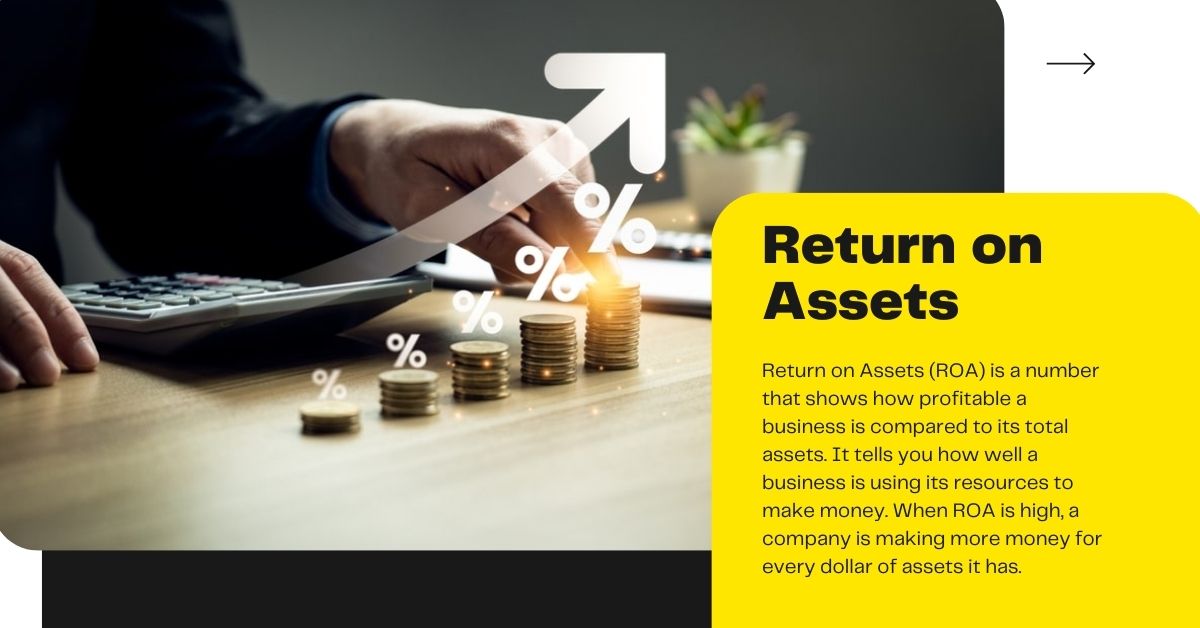The return on assets (ROA) of a business shows how well it utilizes its assets to make money. ROA is a way for managers, researchers, and investors to figure out how healthy a company’s finances are.
What is Return on Assets?

Return on Assets (ROA) is a number that shows how profitable a business is compared to its total assets. It tells you how well a business is using its resources to make money. When ROA is high, a company is making more money for every dollar of assets it has.
What is the ROA Formula?
You can calculate return on assets (ROA) by:
ROA = Net Income / Total Assets
- Net Income: This is how much money the company made after taking out all of its costs, like fees.
- Total Assets: This is everything that a business owns, like cash, inventory, land, plants, and equipment.
By dividing net income by total assets, one can calculate the percentage that represents how much profit a company makes for every dollar of assets it owns.
Example of ROA Calculation
Let’s assume a company has the following financial information:
- Net Income: ₹10,000,000
- Total Assets: ₹50,000,000
Using the ROA formula:
ROA = Net Income / Total Assets ROA = ₹10,000,000 / ₹50,000,000 ROA = 0.20 or 20%
This means that the company makes ₹0.20, or 20%, for every ₹1 it owns in assets. This means that the business can make good use of its assets to earn a 20% return.
How Is ROA Used by Investors?
Return on assets (ROA) is a way for investors to figure out how profitable and efficient a company is. Most of the time, a bigger ROA is a good sign because it means that a company is making more money per dollar of assets. Investors can check if a business is making good use of its resources by comparing its ROA to industry standards and its past performance.
ROA can also help investors find companies that might not be working well or are priced too high. It could mean that a business isn’t as efficient as its peers if its ROA is much lower than that of its peers.
If, on the other hand, a business’s ROA is much higher than its peers, it could mean that the company is not worth as much as it should be. When making investment choices, it’s important to think about other things too, like the company’s growth prospects, competitive edge, and overall financial health.
What Is a Good ROA?
What is considered “good” ROA varies on the business and its circumstances. Most people agree, though, that a ROA of 15% or more is usually a good thing. This means the business is making ₹0.15 in profit for every ₹1 it has in assets.
To get a better idea of how profitable a business is, you should compare its return on assets (ROA) to industry standards and its past performance. For example, a 12% ROA might be good for a company in a very competitive industry, but a higher ROA might be better for a company in a less competitive industry. To get a full picture of a company’s financial health, you should look at its return on assets (ROA) along with other financial measures like return on equity (ROE) and profit margin.
ROA vs. ROE
| Feature | Return on Assets (ROA) | Return on Equity (ROE) |
|---|---|---|
| Formula | Net Income / Total Assets | Net Income / Total Equity |
| Focus | Overall profitability of a company | Profitability of a company’s shareholder investment |
| Factors | Asset efficiency, operating efficiency, financial leverage | Asset efficiency, operating efficiency, financial leverage, leverage |
| Interpretation | Higher ROA indicates better asset utilization | Higher ROE indicates better return on shareholder investment |
| Comparison | Measures profitability relative to total assets | Measures profitability relative to shareholder equity |

